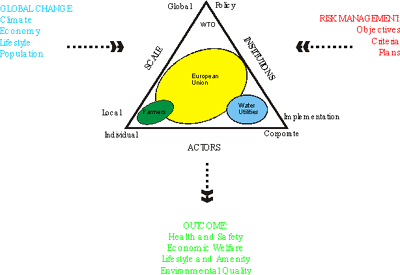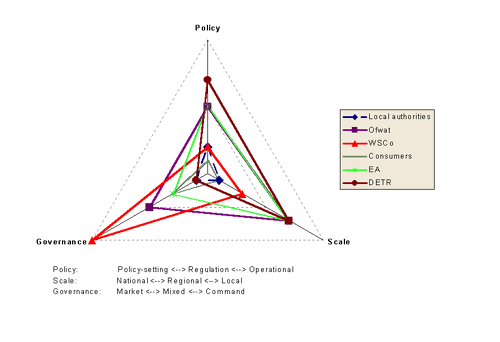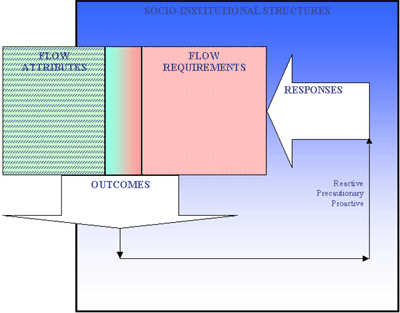| contents
| objectives
| agenda |
key
literature and info sources | what
is a hydrosocial issue? |
traditional
framing of issues | linking
social to hydrological | global
change |
integrating
flow attributes and requirements |
inventory
of issues (write up of course exercise) |
The
FIRMA training course is designed to familiarise the participants
with different domains of expertise relevant to the project,
including hydro-social issues (this presentation), agent-based
modelling (Troitsch et al.), hydrology and aquatic ecosystems
(Cemagref presentations), water use (EAWAG presentation) and
integrated assessment (Rotmans).
This
presentation was given as part of an overview/introductory
session at the beginning of the course. It includes results
of our screening of issues, although this was developed during
the session rather than presented as recommendations.
I
have also added a summary of a session on the following day
that introduced issues in institutional analysis, integrated
assessment and agent-based modelling (the FIRMA pilot model).
Again, these are included for completeness in the FIRMA project
rather than recommendations for other courses, per se.
 objectives objectives
- Introduce
broad themes in water policy that are relevant to the
FIRMA project
-
Demonstrate various means of participatory learning
- Coalesce
on standard terms and definitions for the project
The
main focus of the introduction was to start a collective process
of identifying specific issues that the FIRMA project ought
to work on. The entire session--presentation, participatory
exercise and summary--was about 60 minutes. So this was not
an in-depth ranking/rating of issues. Only a beginning.
The
second objective is also important, especially in a new project
where people are still learning who is who (and we had some
40 people in the course), what they do, what each team wants
to do, and how that can make an effective, collaborative project.
The diversity in the project is huge: of disciplines (computer
science and engineering to political ecology and policy analysis),
the lingua franca was English (difficult enough for speakers
in different disciplines let alone different cultures), the
mix of experience (beginning post-graduate students, new post-docs,
very senior professors, some applied people).
Glossaries
from UK Water and a previous project (SIRCH) were distributed
but not discussed--the technical details of terms tends to
emerge later when people start working on specific issues.
agenda
1.
Background material
EU water directive Glossary
Literature
2.
Introduction to hydro-social issues
3. Agenda setting for further elaboration
4. Meta-model exercise
5.
Case study on institutional analysis of water issues
6.
Log sheet
This
agenda spilled over two days. In the first session we focussed
on the middle spots. EAWAG (Claudia Pahl-Wostl and others)
have developed a participatory method called meta-model building.
This helps clarify assumptions and get people thinking about
the most important issues. This was to be tried later in the
course.
David
Sauri presented 30 minutes on property rights and institutional
development regarding water. It is very far from modelling,
but underlies the larger context of regulation and debate
about economic efficiency and environmental equity. This was
a separate talk on the next day.
We
did not have a full participation/facilitation team in the
course. One useful idea is to keep a flip chart sheet of issues
and questions that the group raised but did not have time
to discuss. These can then be dealt with later or a procedure
adopted to work on them off-line. I called this a log sheet,
others have used terms such as grab bag. It helps to raise
the importance of ideas, while not losing the focus on issues
selected for the current session.
key
literature and sources of information
SIRCH
project: www.eci.ox.ac.uk
-
Working papers on institutional analysis, stakeholders
-
Descriptions of drought/floods in southern England, Netherlands
and southern Spain
Eurowater
project
-
Two volumes edited by Nunes Correra
EU
water issues n summary fact sheets:
- //europa.eu.int/scadplus/leg/en/lvb/...
-
summary of directive: //europa.eu.int/water/water-framework/index_en.html
Ö
The
project recognises that key literature should underpin our
collective work, as well as individual developments. We tried
to circulate a piece of paper where people could suggest the
most important readings, but this did not progress easily.
The
SIRCH project has working papers on institutions, new economics
of institutions, stakeholders, regional applications, demography,
and other topics on its web site. The EuroWater project was
a major inventory of national plans and context, with some
comparisons across Europe and at the EU level.

what
is a hydro-social issue?
Interactions
of hydrology, management and consumers
Recurring
issues
-
Affected by long-term trends in socio-economic conditions
-
Driven by EU policy
-
Relating to national policy
The
inherent notion is that 'hydro-social' is the interaction
of traditional domains of explanation and expertise--the natural
sciences (of which hydrology is one), policy and operational
management (e.g., organisational behaviour) and demand/use
of water (consumers in a broad sense).
The
issues can be identified by looking at recurring debates,
related to changing structures of society and economy, policy
from the top (e.g, the EU) and policy from within (debates
at a national, regional or local level)
traditional
framing of issues from different disciplines:
1.
Hydrological/hydraulic
-
What is the expected yield of a catchment?
2. Engineering
-
How much water leaks from the distribution system?
-
How can leakage be reduced?
3. Management
-
What is the economic level of leakage
 linking
social to hydrological: linking
social to hydrological:
- How
will new investment in water infrastructure be agreed?
-
How can local management structures balance competing
uses?
-
How will stakeholders negotiate water entitlements in
different conditions of water availability, especially
scarcity?
-
How will consumers respond to periodic water shortages,
or to increasing environmental concerns?
There
are contrasting definitions of integrated issues--taken from
the FIRMA proposal. What follows was a way of getting people
thinking about how issues are framed, rather than suggest
a checklist.
global
change

stakeholders

The
analysis of stakeholders is essential. This is a qualitative
example from the SIRCH project.
The
three axes emerge as important, but not necessarily exclusive,
ways to differentiate stakeholders. For example, local authorities
are primarily operational, work at the local scale. The government
environmental ministry (DETR), the Environment Agency (the
environmental regulator) and the Office of Water Services
(the economic regulator) overlap in their jurisdictions. Water
supply companies are private corporations working in this
mixed regulator environment.
integrating
flow attributes and requirements

This
is based on the SIRCH conception of water as an integration
of the physical and social. Some biophysical processes can
be considered outside of the socio-institutional sphere, but
most are directly influenced by human activity. Flow attributes
(the biophysical) and flow requirements (the demand and uses)
overlap--they cannot be defined without recourse to each other
to the extent that purely natural catchments do not exist.
The outcome of that interaction feeds into responses, whether
reactive, precautionary or proactive.
inventory
of issues:
We
need to focus the FIRMA project on specific issues of relevance
to EU, national and local policy. In a group of this size,
a good way to do this is to run a carousel.
Carousel
-
Four stations on defined themes
-
Moderator selected for each station
-
Small group visits each topic in succession
-
Report back to everyone
-
30 minutes total
Groups
on:
- Global
change
- EU
policy--the water directive
-
National and local issues in the Mediterranean
-
National and local issues in northern Europe
The
four themes are shown--they were chosen to reflect different
origins of water policy. But they are arbitrary--other breakdowns
could have been around major issues (quantity, drinking quality,
pollution, non-use values) or users (domestic, agriculture,
industry, environment).
Steps:
- List
hydro-social issues for this topic
-
Review and add to list from previous group
-
Provide examples of the issues--where, who
-
Rank in order of importance in Europe. This final step
is difficult--in the end it is pretty subjective. The
rating was suggested as:
Must do in FIRMA, broad importance, relevant to case studies
Important, but less critical focus for the project, might
be more local than EU- wide
Still worth pursuing, but of less importance than other
issues
Most
groups put three stars against a few issues but did not have
time to rank the lower order importance
inventory
Three
stars
-
Extreme events: drought/floods, infrastructure
-
cross national issues--extreme events, pollution, flooding
n scarcity of water supply
-
full recover costs pricing
-
institutions for conflict resolutions
-
industrial pollution n conflicts on water management
-
agricultural pollution
These
are the three star issues reported back to the plenary by
each group. We reported back by asking each group for their
very most important issue in turn, then cycled around the
groups again asking for the next most important issue. This
helps to put the most important of the important at the top
of the list and to get an even reporting across the groups.
Many of the issues were similar or the same across the groups--they
are grouped together in the above list.
catalogue
Chose
issues as the core set to work on
Relate groups of issues to analytical methods
Lead institutes for further development
-
Background note on issue (1 page)
-
Examples in literature and case study areas (1 page)
-
Suggestions for modelling
The
issues identified are neither exhaustive nor prioritised in
a specific way. The project should go further to identify/rank
issues and provide a bit of background for each issue.
One
way to do this would be for a lead institute to be assigned
this task for each of the priority issues. A key aspect is
to link the issue to methodologies in the modelling domain.
For example, what are the standard models for pollution, what
are the major issues for modelling (e.g., spatial representation
of flows through groundwater is very difficult, requiring
data that do not exist and complex computations--3D, multi-process
flows)
results
from four themes
- Global
change
- European
Union policy w Northern Europe
- Southern
Europe
 1a.
Global change (1) 1a.
Global change (1)
-
Emergence of water rights (UK, California)
-
Water scarcity--droughts, floods
-
Climate change--management
-
Conflicts over water--access
-
Pollution--chemical, agricultural, industrial, hygienic
-
Institutions
-
Land use changes (Spain, afforestation)
-
Changing perceptions of risk w Empowerment of stakeholders--EU
directive
-
Demographic change--single person households
1b.
Global change (2)
-
Precautionary action--global warming w shift in value
systems
-
Hydro-biological change
-
Agricultural practices
-
Technological change--better control of water flows
-
Lower credibility of experts--reflexive modernisation,
e.g., Shell Brent Spar
-
Virtual water/food trade
2a.
European Union policy (1)
-
River basin management w Full recovery costs (pricing)--regulation
vs markets
-
Good ecological quality
-
Inland navigation
-
Drinking water quality
-
Fishing
-
Tourism
 2b.
European Union policy (2) 2b.
European Union policy (2)
-
Sustainable management--costs, benefits
-
Subsidiarity--agreement for quantity not quality or drinking
water
-
Quantity
-
Flood and drought management
-
Theoretical basis of policy analysis
-
Major accidents--toxic spills
-
Conflict resolutions principles
3a.
Northern Europe
-
Flooding and high water (Rhine)
-
Agricultural pollution (Norfolk Broads)
-
Industrial pollution
-
Ecosystem deterioration--rivers, estuaries, seashores
-
Drinking water quality (Rhine/Meuse)
-
Up/downstream water management and conflicts (Rhune, Wye)
-
Law enforcement and penalties (Camelsford and pollution
of drinking water, nuclear discharges)
-
Fish farming
-
Navigation and transportation
-
Cross-national issues (Rhine, Meuse)
3b.
Southern Europe
-
Drought, lack of rain (Balearics)
-
Altered floods and drought
-
Pollution with pesticides
-
Scarcity of water supply (urban) (Barcelona)
-
Too many tourists--demand for quantity and quality; pollution
(Venice)
-
Transfer between basins
-
Coordinate public and private
-
Farm production--irrigation, changing practices (SW France)
-
How to induce changes
 Infrastructure to cope with extreme events (Venice, Majorca)
Infrastructure to cope with extreme events (Venice, Majorca)
analysis
Further
ideas:
-
What is the policy issue?
- Where
is it most apparent?
-
Who are the stakeholders?
-
What is the range of effective action?
-
What are the relationships between stakeholders?
conclusion
We
did not draw together conclusions from the exercise due to
a lack of time. It would be useful to do this, looking at:
1.
Outcome of the exercise--Is this a good list? What more
needs to be done to refine the substance of the exercise.
I quickly sketched out a few ideas, but this was not a group
process and we did not seek to adopt any further action.
2. Procees evaluation--it is a good idea to evaluate the
process as well. Did people like the approach? Did they
have comments for improvements? Did they learn something?
I felt that the exercise achieved its aims--wide participation,
some mixing across regional and age boundaries, a bit of
stirring up, and a good first list of major issues. It may
have had a subsequent effect on the course--I felt there
was less "what should we do?" in the following sessions
and a better focus on methodological issues.
Additional
issues--it can be useful to post an additional sheet to record
things that are brought up but cannot be dealt with at the
time--the log sheet. This can then be looked at and decisions
made as to when the further issues should be discussed.
|




